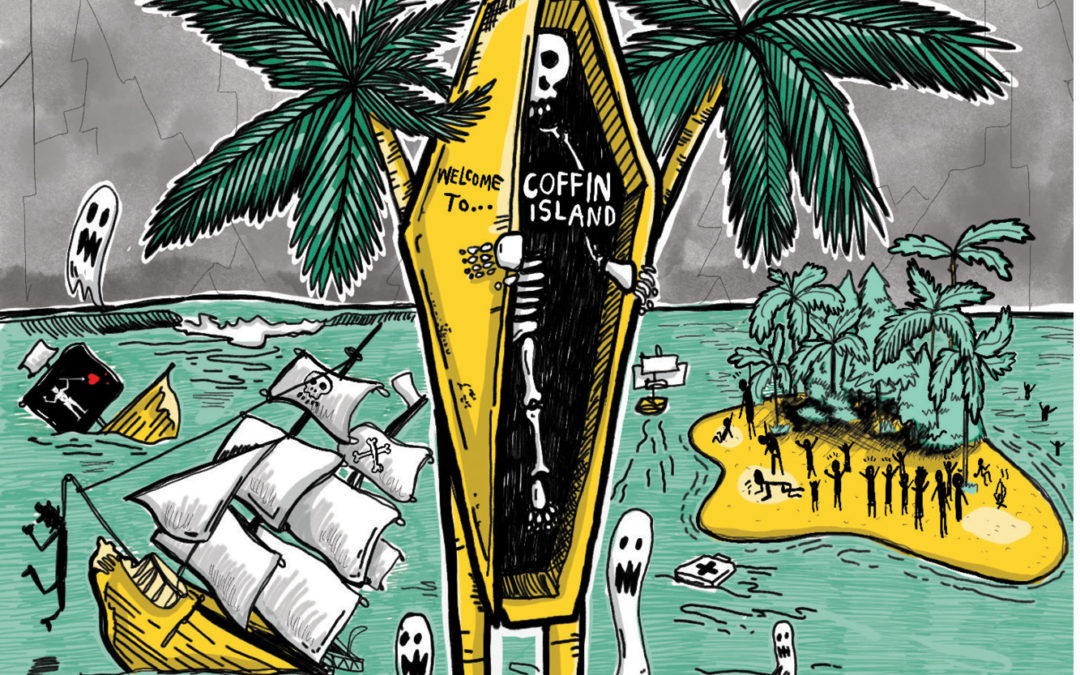A Look At Some of Folly’s Most Haunted Tales
By Lorne Chambers | Editor
Most folks, locals and visitors alike, tend to have happy memories of Folly Beach. Days in the sun, frolicking in the surf, building sandcastles, etc. But Folly Beach has a darker side. It’s not one that’s typically used in marketing materials about our fair island, but with Halloween upon us, we felt it was a good time to delve into some of the lesser-celebrated and even downright macabre parts of our history.
With a history that includes pirates, war, shipwreck, and disease, it’s no wonder that there are more than a couple ghost stories to tell around here. Below are five ghostly and ghastly tales about Folly Beach that would be perfect to tell around a campfire this Halloween.
Some of these tales, such as the Wreck of the Amelia or the Case of the Headless Soldiers, are undoubtedly true and are well-documented. Others, such as the Origin of Coffin Island are debatable. Then there are the others, such as the popular Legend of Buried Pirate Treasure and The Ghost of Blackbeard, which have some historical truths, but definitely fall into the folklore and supernatural realms. Of course … that doesn’t mean they’re not real. That’s for you to decide.
The Origin of Coffin Island
From The College of Charleston’s Educator’s Guide to Folly Island:
Folly Island is also at times labeled Coffin Land or Coffin Island on some historical maps. The significance of this name is still under debate for several reasons. Some believe that it is due to the fact that ships entering Charleston harbor would drop off sick and dying people on the island to avoid becoming quarantined. Others believe it came about from a shipwreck that occurred off the coast of Folly in 1700. This led to many of the bodies of those onboard washing up on the beach. The final inconsistency with the name Coffin Island is that documents also show that name being used for Morris Island as early as 1749.
For the record, the Wikipedia page for Folly Beach states the following (and Wikipedia is never wrong … right?):
For a time, Folly Island was known as Coffin Island not because of deaths or burials, but because of its ownership by the Coffin family, plantation owners of Beaufort and Charleston counties.
The Case of the Headless Soldiers
From Weird Carolinas By Roger Manley:
Fourteen bodies were found in May 1987 when foundations for a construction site at the west end of Folly Beach were excavated. Construction was halted for a month while the South Carolina Institute of Archeology and Anthropology (SCIAA) investigated the remains that were discovered
All of the bodies except one had been buried with shoulders directed to the west. Twelve of the bodies were missing skulls and other major body parts. Some of the burials had coffins; others had only ponchos. With the bodies were found Union Anny eagle buttons, one ‘#5’ insignia from a cap, and Enfield Rifle .57 caliber mini balls.
State archaeologists finally decided the men were from the Union Army’s 55th Massachusetts Volunteer Regiment made up of African-American soldiers. The 55th Regiment was joined on Folly by the 54th Regiment, made popular in the movie Glory.
Because the bodies had no injuries, the possibility of death in battle was eliminated. That left only the possibility of death by illness, head injury, or beheading. There are several (unproven) opinions as to why the remains were minus their skulls. One theory is that bounty hunters sought the skulls of buried Union soldiers when the federal government offered rewards for retrieval of bodies. But the odd thing was that while the skulls were missing, the rest of the bones were undisturbed. It’s not likely bounty hunters would be so respectful when collecting their prizes. Another opinion was that the skulls were removed by local islanders for voodoo rituals.
A final, even scarier, and perhaps more likely theory imagined a scene in which a deranged Confederate commander took things into his own hands, dispensed with official military regulations regarding the proper treatment of his prisoners, and ordered their heads cut off.
Legend of the Buried Pirate Treasure
From Ghosts of the Carolinas By Nancy Roberts:
A Union survivor of the Battle for Morris Island named Francis M. Moore was stationed on Folly during the Civil War wrote that, prior to an ensuing battle for Charleston, a Union Army soldier named Yokum was dispatched to “relocate all Negroes living on Morris Island to Port Royal.”
When speaking with one of the old black women living on the island, Yokum learned of pirates who had buried six treasure chests somewhere on Morris Island. Then she told him that the pirate captain had ruthlessly stabbed one of his men and let the body fall on top of the chests before covering them up. She said the chests were still there but no one would go near the trees because the dead pirate’s ghost was guarding the treasure.
Around midnight that night, Yokum and Lt. Hatcher left their camp with shovels to find the treasure. Though it was a windless night, as the men began to dig, the tops of the trees started to sway as if a hurricane was approaching. Lightning flashed, but no thunder followed. They continued to dig. Lightning flashed again and lingered for a while. Suddenly the men realized they were not alone. In the strange prolonged lightning they saw the clear figure of the pirate. They dropped their shovels and ran for their lives. On Morris Island the next day the attack began and they were never able to return to the treasure site.
It wasn’t until 50 years later that Yokum retold his story at a veterans’ reunion where it was supposedly recorded.
Wreck of The Amelia
From Time and Tide on Folly Beach, South Carolina By Gretchen Stringer-Robinson:
In 1832, the Amelia wrecked on Folly Island while sailing from New York to New Orleans. Of 120 passengers, twenty died of cholera while marooned on Folly Beach. Charleston, in a panic over a possible epidemic, cut off communications and supplies to the island. On November 9, 1832, they burned the wreck and cargo. A man from the City went to the wreck and upon his return to Charleston was fatally attacked. A patrol was set up, to guard against other diseased visitors from Folly. In 1837 the South Carolina General Assembly allocated a settlement for damages to the victims.
The Ghost of Blackbeard
From Why Is Charleston So Haunted? on The Bulldog Tours website:
Folly Island is haunted by the ghost of Blackbeard. Blackbeard once blockaded Charleston and threatened to burn the city. He used Folly Island as his hideout and even had a house there, which has since been destroyed by a hurricane. Civil War soldiers as well as a confederate officer have reportedly been spotted at and around the Morris Island lighthouse on the edge of Folly. The police and Coast Guard have also been called out there for over 100 years, because people have spotted a woman in a white dress and apron standing in the doorway of the lighthouse.


